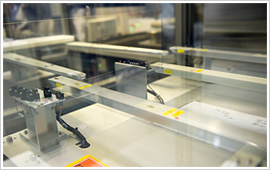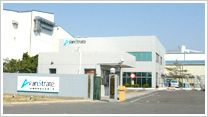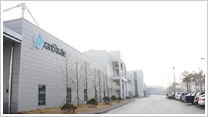Product features created by sophisticated production process

Surface irregularities can affect the display quality of LCD glass substrates, even at the nanometer level. If we were to explain this by comparing a 7th-generation substrate (1,870 x 2,200 mm) to a soccer field, then even a 5-mm grain of rice on the field would be unacceptable and any bumps should be lower than 0.5 mm.
When working the glass, extreme care is taken to avoid surface scratches left by fine particles and minute dust adhered to the glass. AvanStrate uses various techniques to overcome these major hurdles and is striving every day to make technological innovations and improvements.
There is a recent technological trend of cutting multiple LCD panels out of a large glass substrate to increase production efficiency. Therefore, it is absolutely necessary to have a large glass-melting furnace as well as advanced techniques and plenty of expertise to develop the composition of glass that is used to make substrates. Because of the advanced technological skills and production facilities required, there are only four manufacturers in the world that are mass-producing LCD glass substrates and AvanStrate is the one of them.
Collaboration with overseas offices to meet the changing needs and demands of customers
AvanStrate's customers, specifically LCD panel manufacturers, are concentrated in Asian countries such as Japan, Korea, Taiwan and China. To cope with this situation, we have established a production and sales system in four offices (in Japan, Korea, Taiwan and Singapore). In addition to setting up the production facilities, we have established a business and customer satisfaction (CS) system in all four offices to carry out marketing so that the local customer information can be quickly reflected in our products. This is our major advantage.
Moreover, not only can we meet the needs of customers in each country, but we can also transfer products and mother glass sheets quickly and flexibly between the four locations depending on changes in demand. In particular, the Singapore office serves as a supply base mainly for customers in other countries, while flexibly changing shipping destinations in accordance with variations in demand. In other words, all four offices collaborate with one another to create a system that can quickly and flexibly respond to the ever-changing needs and demands of our customers.








